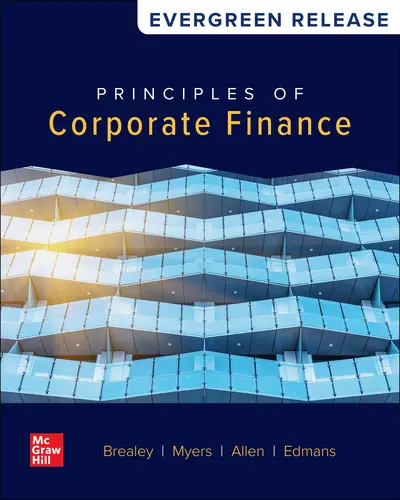My Account Details

ISBN10: 1266586156 | ISBN13: 9781266586156

* The estimated amount of time this product will be on the market is based on a number of factors, including faculty input to instructional design and the prior revision cycle and updates to academic research-which typically results in a revision cycle ranging from every two to four years for this product. Pricing subject to change at any time.
Instructor Information
Quick Actions (Only for Validated Instructor Accounts):
Brealey: Principles of Corporate Finance bridges the gap between financial theory and practical application for corporate finance. It emphasizes the importance of understanding financial theory to adapt to non-routine situations and evolving market conditions. By explaining why companies and financial markets behave as they do, the book equips managers with the tools to make informed decisions, not just based on experience but backed by theory. The authors address controversies within financial theory, offering balanced viewpoints while emphasizing practical applications to increase company value.
The latest edition of Principles of Corporate Finance represents a significant step forward in both clarity and pedagogy. Every chapter has been revised—some extensively—incorporating the expertise of Alex Edmans, a distinguished scholar in corporate finance. Principles focuses on making complex concepts more intuitive by breaking down dense material into bite-sized, easy-to-digest sections. Key terms and principles are now highlighted for quick reference, and long lists have been reorganized into structured bullet points with brief summaries. Where appropriate, mathematical and theoretical explanations have been replaced with real-world analogies and practical insights to ensure concepts resonate beyond the classroom.
To further enhance student learning, Principles has expanded its Beyond the Page chapter features, now offering over 150 interactive applications that bring financial concepts to life. These resources allow students to explore real-world case studies, from understanding GameStop’s speculative trading frenzy to analyzing the impact of COVID-19 on stock risk. New Sense Check boxes encourage students to critically assess financial calculations, ensuring they develop the intuition needed to avoid common errors in professional settings. Meanwhile, Common Confusions sections clarify frequently misunderstood concepts, helping students build a stronger foundation in corporate finance. Whether through the printed text, the interactive eBook, or Principles' extensive Connect tools, this edition provides a richer, more engaging learning experience than ever before.
1. Introduction to Corporate Finance
2. How to Calculate Present Values
3. Valuing Bonds
4. Valuing Stocks
5. Net Present Value and Other Investment Criteria
6. Making Investment Decisions with the Net Present Value Rule
PART TWO: RISK
7. Risk, Diversification, and Portfolio Selection
8. The Capital Asset Pricing Model
9. Risk and the Cost of Capital
PART THREE: BEST PRACTICES IN CAPITAL BUDGETING
10. Project Analysis
11. How to Ensure That Projects Truly Have Positive NPVs
PART FOUR: FINANCING DECISIONS AND MARKETING EFFICIENCY
12. Efficient Markets and Behavioral Finance
13. An Overview of Corporate Financing
14. How Companies Issue Securities
PART FIVE: PAYOUT POLICY AND CAPITAL STRUCTURE
15. Payout Policy
16. Capital Structure in Perfect Capital Markets
17. How Much Should a Corporation Borrow?
18. Financing and Valuation
PART SIX: CORPORATE OBJECTIVES AND GOVERNANCE
19. Corporate Governance
20. Stakeholder Capitalism and Responsible Business
PART SEVEN: OPTIONS
21. Understanding Options
22. Valuing Options
23. Real Options
PART EIGHT: DEBT FINANCING
24. Credit Risk and the Value of Corporate Debt
25. The Many Different Kinds of Debt
26. Leasing
PART NINE: RISK MANAGEMENT
27. Managing Risk
28. International Financial Management
PART TEN: FINANCIAL PLANNING AND WORKING CAPITAL MANAGEMENT
29. Financial Analysis
30. Financial Planning
31. Working Capital Management
PART ELEVEN: MERGERS, CORPORATE CONTROL, AND GOVERNANCE
32. Mergers
33. Corporate Restructuring
PART TWELVE: CONCLUSION
34. Conclusion: What We Do and Do Not Know about Finance
Need support? We're here to help - Get real-world support and resources every step of the way.